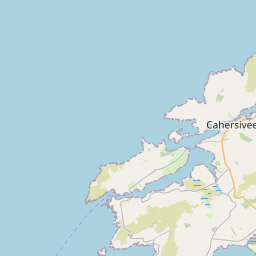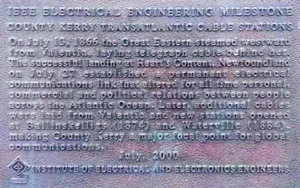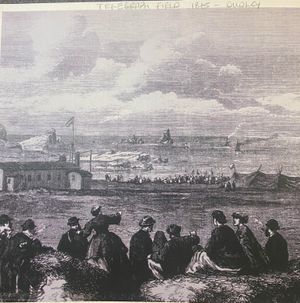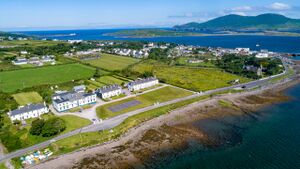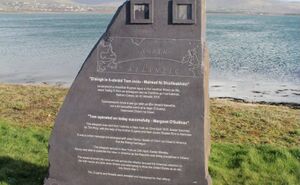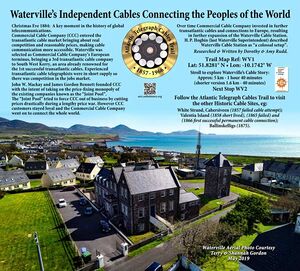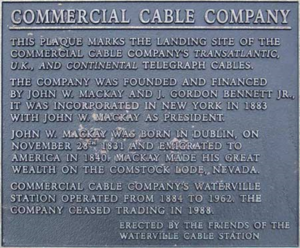Milestones:County Kerry Transatlantic Cable Stations, 1866: Difference between revisions
No edit summary |
No edit summary |
||
| (5 intermediate revisions by the same user not shown) | |||
| Line 13: | Line 13: | ||
==County Kerry Transatlantic Cable Stations, 1866== | ==County Kerry Transatlantic Cable Stations, 1866== | ||
[[image: | [[image:CountyKerry-Plaque.png|thumb]] | ||
[[Image:Valentia_telegraph_field_1865_cropped.jpg|thumb|right|Cable field at Valentia in 1865 from the ''Illustrated London News'']] | [[Image:Valentia_telegraph_field_1865_cropped.jpg|thumb|right|Cable field at Valentia in 1865 from the ''Illustrated London News'']] | ||
[[image:Waterville-Landing-Point.png|thumb| | [[image:Knightstown-Valentia-Island.jpg|thumb|Site 1: Valentia Island: Valentia Transatlantic Cable Station in left foreground, adjoining Knightstown]] | ||
[[image:ValentiaCableStationMarker.jpg|thumb|Site 1: Valentia Cable Station marker for 1916 coded telegram alerting America that the Irish Easter Rising had begun]] | |||
[[image:WatervilleCableStation.jpg|thumb|Site 2: Waterville Cable Station information for Cables Trail | |||
]] | |||
[[image:Waterville-Landing-Point.png|thumb|Roadside historical marker at Waterville Cable Station's cable landing site (near Site 2)]] | |||
[[image:BallinskelligsCableStationEmblem.png|thumb|Site 3: Ballinskelligs Cable Station emblem for Cables Trail Map]] | |||
[[image:AtlanticCablesExhibition.png|thumb|Emblem for Atlantic Cables Exhibition, at Cafe Cois Trá (just south of Site 3)]] | |||
== Citation == | |||
County Kerry, Ireland, July 2000 - [[IEEE United Kingdom and Republic of Ireland Section History|IEEE UKRI Section]] | County Kerry, Ireland, July 2000 - [[IEEE United Kingdom and Republic of Ireland Section History|IEEE UKRI Section]] | ||
| Line 23: | Line 36: | ||
''On July 13, 1866 the [[Great Eastern|Great Eastern]] steamed westward from Valentia, laying telegraph cable behind her. The successful landing at Heart's Content, Newfoundland on July 27 established a permanent electrical communications link that altered for all time personal, commercial and political relations between people across the Atlantic Ocean. Later, additional cables were laid from Valentia and new stations opened at Ballinskelligs (1874) and Waterville (1884), making County Kerry a major focal point for global communications.'' | ''On July 13, 1866 the [[Great Eastern|Great Eastern]] steamed westward from Valentia, laying telegraph cable behind her. The successful landing at Heart's Content, Newfoundland on July 27 established a permanent electrical communications link that altered for all time personal, commercial and political relations between people across the Atlantic Ocean. Later, additional cables were laid from Valentia and new stations opened at Ballinskelligs (1874) and Waterville (1884), making County Kerry a major focal point for global communications.'' | ||
== Street address(es) and GPS coordinates of the Milestone Plaque Sites == | |||
*Site 1: The Promenade, Farranreagh, Knightstown V23 H685, Valentia Island, County Kerry, Ireland (51.92196, -10.28846) | |||
*Site 2: 9 Iveragh Terrace, Waterville V23 X862, on the Iveragh Peninsula, County Kerry, Ireland (51.83143, -10.17191) | |||
*Site 3: Kinnard House, Cois Trá Lower (Road R566), Dungeagan, Ballinskelligs V23 PW50, on the Iveragh Peninsula, County Kerry, Ireland (51.824758, -10.272836) | |||
== Details of the physical location of the plaque== | |||
*Site 1: on a white pillar at the right side of the street entrance to the Eighth Wonder - Transatlantic Cable Station museum (the original Valentia Transatlantic Cable Station), now a UNESCO World Heritage Site | |||
*Site 2: on a white pillar at the end of a wall at the street entrance to The Old Cable House (the original Waterville Cable Station), which now houses Mary Loos Seafood | |||
*Site 3: on the Kinnard House roadside concrete wall, on the west side of Road R566; Kinnard House is on the site of the now-demolished Ballinskelligs Cable Station Superintendent's house | |||
== How the plaque site is protected/secured== | |||
*Site 1: local police; 24/7 access | |||
*Site 2: local police; 24/7 access | |||
*Site 3: local police; 24/7 access | |||
== Historical significance == | |||
The discoveries of electricity in the latter half of the 18th Century, and its close connection with magnetism, were the products of earlier experiments, which in turn led to the invention of the electric telegraph. [[Telegraph|Telegraphy]] had connected the interior of the United States, and it also connected Europe together. However, connecting the Americas and Europe proved to be a challenge. Due to the electric current that ran through the cable lines, insulation and waterproofing was necessary. The discovery of gutta percha, a gum like substance proved to be a satisfactory waterproof insulator. | The discoveries of electricity in the latter half of the 18th Century, and its close connection with magnetism, were the products of earlier experiments, which in turn led to the invention of the electric telegraph. [[Telegraph|Telegraphy]] had connected the interior of the United States, and it also connected Europe together. However, connecting the Americas and Europe proved to be a challenge. Due to the electric current that ran through the cable lines, insulation and waterproofing was necessary. The discovery of gutta percha, a gum like substance proved to be a satisfactory waterproof insulator. | ||
| Line 31: | Line 62: | ||
A new company, the Anglo American Telegraph Co. raised £600,000 to make another attempt at laying the cable. The Great Eastern was overhauled, and in June 1866 the ship left Valentia, Ireland and sailed for Trinity Bay without mishap. The cable arrived at [[Milestones:Landing of the Transatlantic Cable, 1866|Heart's Content, (corresponding IEEE Milestone)]] on 27 July 1866. Europe and the Americas had finally been connected. The Great Eastern was also able to recover the 1865 cable, and two Atlantic cables were working. | A new company, the Anglo American Telegraph Co. raised £600,000 to make another attempt at laying the cable. The Great Eastern was overhauled, and in June 1866 the ship left Valentia, Ireland and sailed for Trinity Bay without mishap. The cable arrived at [[Milestones:Landing of the Transatlantic Cable, 1866|Heart's Content, (corresponding IEEE Milestone)]] on 27 July 1866. Europe and the Americas had finally been connected. The Great Eastern was also able to recover the 1865 cable, and two Atlantic cables were working. | ||
== Significant references == | |||
*[https://www.worldheritageireland.ie/tentative-property/trans-atlantic-cable-ensemble/ UNESCO World Heritage Site: Valentia Cable Station] | |||
*[https://www.irishamerica.com/2013/09/valentia-islands-buried-treasure/ Valentia Island’s Buried Treasure] | |||
*[https://storymaps.arcgis.com/stories/e1dc8a7d6b0d46a3998a00dfb5e071f9 Atlantic Telegraph Cables Trail] | |||
*[https://atlantic-cable.com/Article/CableTrail/index.htm Cable History Trail] | |||
*[https://blog.prepscholar.com/driving-the-ring-of-kerry-maps-route Driving Ireland's Ring of Kerry] | |||
*[https://atlantic-cable.com/NF2001/CCPaper/ The Transatlantic Cable Stations: An Irish Perspective] | |||
*[https://www.loc.gov/item/2005694829?loclr=blogtea The telegraphic messages of Queen Victoria and US President Buchanan] | |||
*Video Documentary: [https://www.youtube.com/watch?v=ywSJ7-Qri9w&app=desktop Valentia Island and The Telegraph Field] | |||
{{Milestone|GeoLoc=51.892548,-10.389205|Description=Cable Station, Waterville, County Kerry, Ireland. July 2000 - IEEE UKRI Section. On July 13, 1866 the Great Eastern steamed westward from Valentia, laying telegraph cable behind her. The successful landing at Heart's Content, Newfoundland on July 27 established a permanent electrical communications link that altered for all time personal, commercial and political relations between people across the Atlantic Ocean. Later, additional cables were laid from Valentia and new stations opened at Ballinskelligs (1874) and Waterville (1884), making County Kerry a major focal point for global communications.}} | {{Milestone|GeoLoc=51.892548,-10.389205|Description=Cable Station, Waterville, County Kerry, Ireland. July 2000 - IEEE UKRI Section. On July 13, 1866 the Great Eastern steamed westward from Valentia, laying telegraph cable behind her. The successful landing at Heart's Content, Newfoundland on July 27 established a permanent electrical communications link that altered for all time personal, commercial and political relations between people across the Atlantic Ocean. Later, additional cables were laid from Valentia and new stations opened at Ballinskelligs (1874) and Waterville (1884), making County Kerry a major focal point for global communications.}} | ||
Latest revision as of 21:04, 13 December 2024
- Date Dedicated
- 2000-07-13
- Dedication #
- 32
- Location
- County Kerry, Ireland
- IEEE Regions
- 8
- IEEE sections
- United Kingdom and Ireland
- Achievement date range
- 1866
County Kerry Transatlantic Cable Stations, 1866
Citation
County Kerry, Ireland, July 2000 - IEEE UKRI Section
On July 13, 1866 the Great Eastern steamed westward from Valentia, laying telegraph cable behind her. The successful landing at Heart's Content, Newfoundland on July 27 established a permanent electrical communications link that altered for all time personal, commercial and political relations between people across the Atlantic Ocean. Later, additional cables were laid from Valentia and new stations opened at Ballinskelligs (1874) and Waterville (1884), making County Kerry a major focal point for global communications.
Street address(es) and GPS coordinates of the Milestone Plaque Sites
- Site 1: The Promenade, Farranreagh, Knightstown V23 H685, Valentia Island, County Kerry, Ireland (51.92196, -10.28846)
- Site 2: 9 Iveragh Terrace, Waterville V23 X862, on the Iveragh Peninsula, County Kerry, Ireland (51.83143, -10.17191)
- Site 3: Kinnard House, Cois Trá Lower (Road R566), Dungeagan, Ballinskelligs V23 PW50, on the Iveragh Peninsula, County Kerry, Ireland (51.824758, -10.272836)
Details of the physical location of the plaque
- Site 1: on a white pillar at the right side of the street entrance to the Eighth Wonder - Transatlantic Cable Station museum (the original Valentia Transatlantic Cable Station), now a UNESCO World Heritage Site
- Site 2: on a white pillar at the end of a wall at the street entrance to The Old Cable House (the original Waterville Cable Station), which now houses Mary Loos Seafood
- Site 3: on the Kinnard House roadside concrete wall, on the west side of Road R566; Kinnard House is on the site of the now-demolished Ballinskelligs Cable Station Superintendent's house
How the plaque site is protected/secured
- Site 1: local police; 24/7 access
- Site 2: local police; 24/7 access
- Site 3: local police; 24/7 access
Historical significance
The discoveries of electricity in the latter half of the 18th Century, and its close connection with magnetism, were the products of earlier experiments, which in turn led to the invention of the electric telegraph. Telegraphy had connected the interior of the United States, and it also connected Europe together. However, connecting the Americas and Europe proved to be a challenge. Due to the electric current that ran through the cable lines, insulation and waterproofing was necessary. The discovery of gutta percha, a gum like substance proved to be a satisfactory waterproof insulator.
In the 1850s a number of attempts were made to lay a cable between Ireland and Newfoundland. In 1864 two investors put up the capital and the Great Eastern was offered to Cyrus Field to lay a cable. The Great Eastern was five times larger than any vessel afloat at the time. She was able to carry the entire new cable, which weighed 7,000 tons. The 2,600 miles of cable could be lowered in a continuous line from Ireland to Newfoundland. In June 1865 the Great Eastern arrived at Valentia and began laying the cable. Within 600 miles of Newfoundland the cable snapped and sank. The Great Eastern, after making several attempts to recover the cable without success, returned to Ireland.
A new company, the Anglo American Telegraph Co. raised £600,000 to make another attempt at laying the cable. The Great Eastern was overhauled, and in June 1866 the ship left Valentia, Ireland and sailed for Trinity Bay without mishap. The cable arrived at Heart's Content, (corresponding IEEE Milestone) on 27 July 1866. Europe and the Americas had finally been connected. The Great Eastern was also able to recover the 1865 cable, and two Atlantic cables were working.
Significant references
- UNESCO World Heritage Site: Valentia Cable Station
- Valentia Island’s Buried Treasure
- Atlantic Telegraph Cables Trail
- Cable History Trail
- Driving Ireland's Ring of Kerry
- The Transatlantic Cable Stations: An Irish Perspective
- The telegraphic messages of Queen Victoria and US President Buchanan
- Video Documentary: Valentia Island and The Telegraph Field
Map

